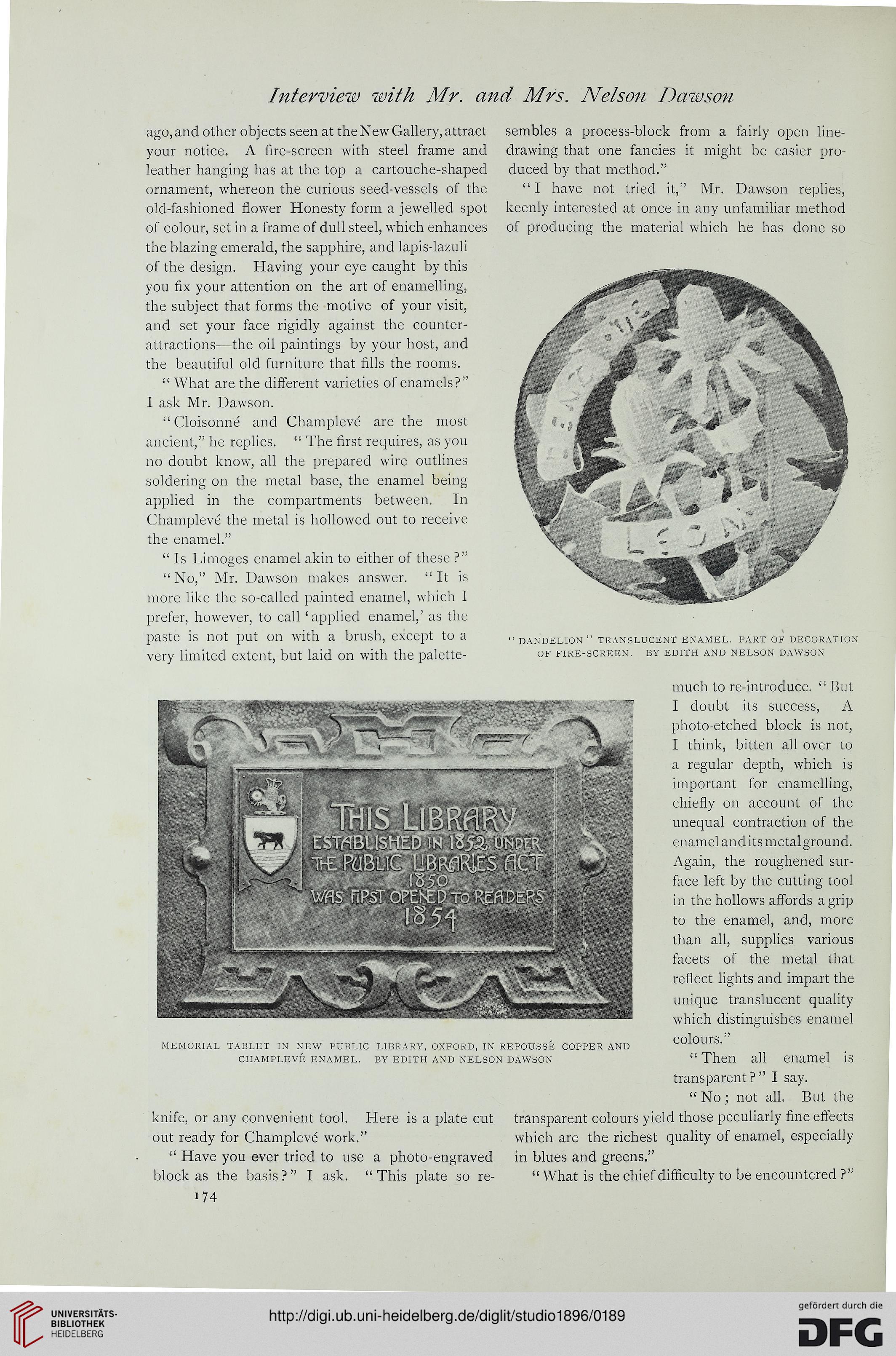Interview with Mr. and Mrs. Nelson Dawson
ago, and other objects seen at the New Gallery, attract sembles a process-block from a fairly open line-
your notice. A fire-screen with steel frame and drawing that one fancies it might be easier pro-
leather hanging has at the top a cartouche-shaped duced by that method."
ornament, whereon the curious seed-vessels of the " I have not tried it," Mr. Dawson replies,
old-fashioned flower Honesty form a jewelled spot keenly interested at once in any unfamiliar method
of colour, set in a frame of dull steel, which enhances of producing the material which he has done so
the blazing emerald, the sapphire, and lapis-lazuli
of the design. Having your eye caught by this
you fix your attention on the art of enamelling,
the subject that forms the motive of your visit,
and set your face rigidly against the counter-
attractions—the oil paintings by your host, and
the beautiful old furniture that fills the rooms.
" What are the different varieties of enamels?"
I ask Mr. Dawson.
" Cloisonne and Champleve are the most
ancient," he replies. " The first requires, as you
no doubt know, all the prepared wire outlines
soldering on the metal base, the enamel being
applied in the compartments between. In
Champleve the metal is hollowed out to receive
the enamel."
" Is Limoges enamel akin to either of these ?"
" No," Mr. Dawson makes answer. " It is
more like the so-called painted enamel, which 1
prefer, however, to call 'applied enamel,' as the
paste is not put on with a brush, except to a " dandelion " translucent enamel, part of decoration
very limited extent, but laid on with the palette- of fire-screen, by edith and nelson dawson
much to re-introduce. " But
I doubt its success, A
photo-etched block is not,
I think, bitten all over to
a regular depth, which is
important for enamelling,
chiefly on account of the
unequal contraction of the
enamel and its metal ground.
Again, the roughened sur-
face left by the cutting tool
in the hollows affords a grip
to the enamel, and, more
than all, supplies various
facets of the metal that
reflect lights and impart the
unique translucent quality
which distinguishes enamel
colours "
memorial tablet in new public library, oxford, in repousse copper and
champleve enamel. by edith and nelson dawson " Then all enamel is
transparent?" I say.
" No ; not all. But the
knife, or any convenient tool. Here is a plate cut transparent colours yield those peculiarly fine effects
out ready for Champleve work." which are the richest quality of enamel, especially
" Have you ever tried to use a photo-engraved in blues and greens."
block as the basis?" I ask. "This plate so re- " What is the chief difficulty to be encountered ?"
i74
ago, and other objects seen at the New Gallery, attract sembles a process-block from a fairly open line-
your notice. A fire-screen with steel frame and drawing that one fancies it might be easier pro-
leather hanging has at the top a cartouche-shaped duced by that method."
ornament, whereon the curious seed-vessels of the " I have not tried it," Mr. Dawson replies,
old-fashioned flower Honesty form a jewelled spot keenly interested at once in any unfamiliar method
of colour, set in a frame of dull steel, which enhances of producing the material which he has done so
the blazing emerald, the sapphire, and lapis-lazuli
of the design. Having your eye caught by this
you fix your attention on the art of enamelling,
the subject that forms the motive of your visit,
and set your face rigidly against the counter-
attractions—the oil paintings by your host, and
the beautiful old furniture that fills the rooms.
" What are the different varieties of enamels?"
I ask Mr. Dawson.
" Cloisonne and Champleve are the most
ancient," he replies. " The first requires, as you
no doubt know, all the prepared wire outlines
soldering on the metal base, the enamel being
applied in the compartments between. In
Champleve the metal is hollowed out to receive
the enamel."
" Is Limoges enamel akin to either of these ?"
" No," Mr. Dawson makes answer. " It is
more like the so-called painted enamel, which 1
prefer, however, to call 'applied enamel,' as the
paste is not put on with a brush, except to a " dandelion " translucent enamel, part of decoration
very limited extent, but laid on with the palette- of fire-screen, by edith and nelson dawson
much to re-introduce. " But
I doubt its success, A
photo-etched block is not,
I think, bitten all over to
a regular depth, which is
important for enamelling,
chiefly on account of the
unequal contraction of the
enamel and its metal ground.
Again, the roughened sur-
face left by the cutting tool
in the hollows affords a grip
to the enamel, and, more
than all, supplies various
facets of the metal that
reflect lights and impart the
unique translucent quality
which distinguishes enamel
colours "
memorial tablet in new public library, oxford, in repousse copper and
champleve enamel. by edith and nelson dawson " Then all enamel is
transparent?" I say.
" No ; not all. But the
knife, or any convenient tool. Here is a plate cut transparent colours yield those peculiarly fine effects
out ready for Champleve work." which are the richest quality of enamel, especially
" Have you ever tried to use a photo-engraved in blues and greens."
block as the basis?" I ask. "This plate so re- " What is the chief difficulty to be encountered ?"
i74




